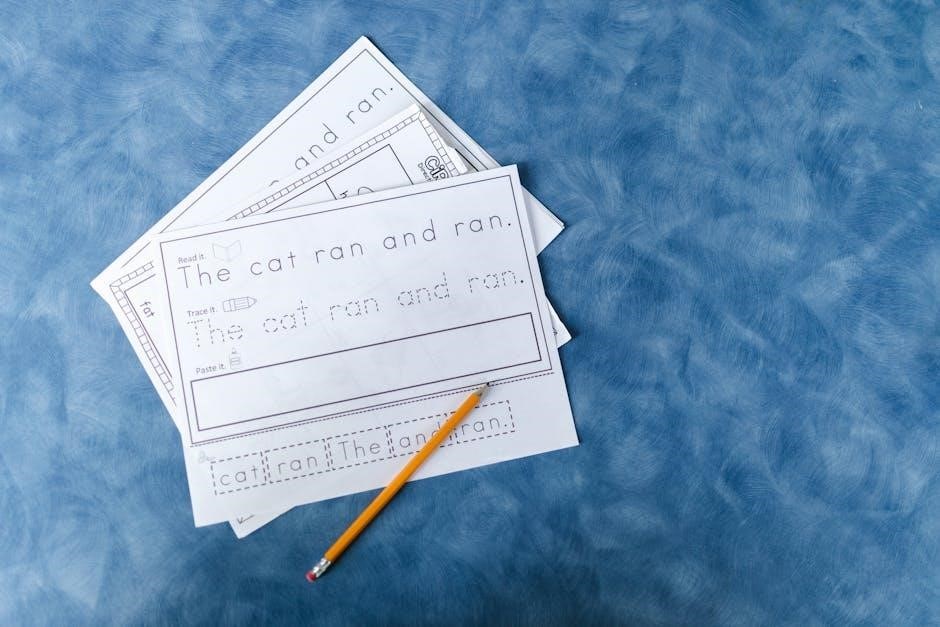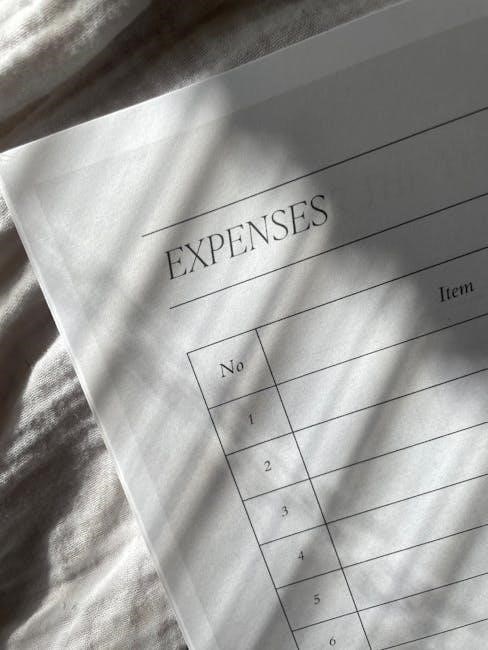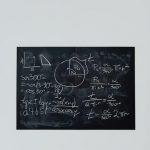
Multiplying decimals is a fundamental math skill essential for everyday calculations. Decimals represent fractions of whole numbers, aiding in precise measurements and financial transactions. Mastering this skill enhances problem-solving abilities and real-world applications. The Multiplying Decimals Worksheet PDF offers structured practice, ensuring confident and accurate computation through various exercises and word problems.
1.1 What Are Decimals?
Decimals are numbers that represent fractions of whole numbers, using a decimal point to separate the whole number part from the fractional part. For example, in the number 4.25, the 4 is the whole number, and the 25 represents 25 hundredths. Decimals are essential for precise measurements, financial calculations, and scientific applications. They allow for greater accuracy in quantities that cannot be expressed as whole numbers alone. Understanding decimals is fundamental for mastering operations like multiplication, as they appear in everyday scenarios, such as money, cooking, and engineering. The ability to work with decimals enhances problem-solving skills and ensures accuracy in real-world applications.
1.2 Importance of Mastering Decimal Multiplication
Mastery of decimal multiplication is crucial for various aspects of life, from everyday budgeting to complex scientific calculations. Accurate decimal multiplication ensures precision in financial transactions, cooking measurements, and engineering projects. It enhances problem-solving skills and builds a strong foundation for advanced math. Practicing with resources like the Multiplying Decimals Worksheet PDF helps students gain confidence and fluency, reducing errors in real-world applications. This skill is indispensable for anyone aiming to excel in mathematics or pursue STEM careers, as it fosters logical thinking and attention to detail, essential for tackling intricate problems effectively.
1.3 Overview of the Multiplying Decimals Worksheet PDF
The Multiplying Decimals Worksheet PDF is a structured resource designed to help learners master decimal multiplication through targeted practice. It offers a variety of problem types, including single-digit, multi-digit, and word problems, ensuring comprehensive skill development. The worksheet gradually increases in difficulty, starting with simple calculations and progressing to more complex scenarios. This approach allows learners to build confidence and fluency step-by-step. Featuring clear instructions and an organized format, the PDF is ideal for both classroom use and independent study. Its focus on real-world applications makes it a practical tool for reinforcing mathematical concepts and preparing for everyday challenges. Regular use of this worksheet promotes consistent practice and lasting mastery of decimal multiplication.

Basic Concepts of Decimal Multiplication
Decimal multiplication involves aligning decimal points, counting total decimal places, and applying whole-number multiplication. This method ensures accuracy and simplifies calculations for learners at all levels.
2.1 Understanding Place Value in Decimals
Understanding place value is crucial for mastering decimal multiplication. Decimals are fractions of whole numbers, with each digit representing tenths, hundredths, or thousandths. For example, in 0.123, 1 is in the tenths place, 2 in the hundredths, and 3 in the thousandths. This structure helps in aligning decimal points during multiplication. When multiplying, the total number of decimal places in both numbers determines where the decimal point is placed in the product. For instance, multiplying 0.12 (two decimal places) by 0.34 (two decimal places) results in a product with four decimal places. Worksheets often include exercises that emphasize this concept, ensuring learners grasp how place value affects multiplication outcomes. Accurate placement is essential for correct results, making this foundational skill indispensable for further progress.
2.2 The Shortcut Method for Multiplying Decimals
The shortcut method for multiplying decimals simplifies calculations by eliminating the need to track decimal points during multiplication. To use this method, multiply the numbers as if they were whole numbers, ignoring the decimal points. After obtaining the product, count the total number of decimal places in both original numbers. Place the decimal point in the product so that the number of digits to the right of the decimal equals the total counted. For example, multiplying 1.2 (one decimal place) by 0.4 (one decimal place) gives 0.48. This method ensures accuracy and efficiency, especially when combined with practice from the Multiplying Decimals Worksheet PDF.
2.3 Converting Decimals to Whole Numbers for Simplified Calculation
Converting decimals to whole numbers streamlines multiplication by eliminating decimal placement concerns. To do this, multiply both numbers by a power of ten to remove the decimal points. For example, to multiply 2.5 by 0.4, convert them to 25 and 4 by multiplying by 10 and 100, respectively. Multiply 25 by 4 to get 100. After obtaining the product, divide by the same power of ten used initially (100 in this case) to place the decimal correctly, resulting in 10. This method reduces errors and simplifies calculations, especially when practicing with the Multiplying Decimals Worksheet PDF. It’s a practical technique for building confidence in decimal multiplication skills.

Strategies for Effective Practice

Effective practice involves starting with basic concepts, using visual aids, and incorporating games. Feedback and self-correction are key to improving decimal multiplication skills through consistent practice and review.
3.1 Step-by-Step Guide for Beginners
Mastering decimal multiplication starts with a clear, step-by-step approach. Begin by multiplying the numbers as if they were whole numbers, ignoring the decimal points. Next, count the total number of decimal places in both numbers and place the decimal point in the product accordingly. For example, multiplying 2.5 by 3.2 involves first calculating 25 × 32 = 800, then placing the decimal point three places to the left, resulting in 8.00. Practice with smaller numbers to build confidence, then gradually move to more complex problems. Use column multiplication for alignment and clarity. Regular practice with worksheets and real-world examples, like calculating total costs or recipe ingredients, reinforces these skills effectively.
3.2 Intermediate Strategies for Faster Calculations
For intermediate learners, mastering decimal multiplication can be streamlined with efficient strategies. One approach is to convert decimals to whole numbers by multiplying both numbers by a power of ten, eliminating the decimal points temporarily. This simplifies the calculation, and the decimal point can be reinserted after obtaining the product. Additionally, column multiplication can be optimized by aligning numbers properly and focusing on place value. Simplifying problems by breaking them into smaller parts or using mental math for familiar multiples saves time. Regular practice with mixed-problem worksheets helps build speed and accuracy. Incorporating real-world examples, such as calculating total costs or scaling recipes, further enhances fluency and practical application.
3.3 Advanced Techniques for Complex Problems
Advanced techniques for multiplying decimals involve tackling complex problems with precision and efficiency. One method is to use estimation to check the reasonableness of answers, ensuring alignment with expected results. Another strategy is to apply inverse operations, such as division, to verify solutions. For multi-step problems, breaking them into smaller, manageable parts reduces complexity. Leveraging mathematical properties, like the associative and commutative properties, can simplify calculations. Additionally, incorporating word problems and real-world scenarios enhances understanding and application. Using worksheets with varied difficulty levels allows learners to gradually build proficiency. These techniques, combined with consistent practice, empower individuals to handle intricate decimal multiplication challenges with confidence.

The Role of Worksheets in Learning
Worksheets play a crucial role in reinforcing decimal multiplication skills through structured practice. They provide a clear format for problem-solving, helping learners build confidence and accuracy in calculations.

4.1 Benefits of Using Printable Worksheets
Printable worksheets offer numerous benefits for learning decimal multiplication. They provide structured practice, ensuring consistent improvement in accuracy and speed. Worksheets cater to different learning levels, from basic to advanced problems, allowing learners to progress at their own pace. The variety of exercises helps reinforce concepts, while word problems enhance real-world application skills. Printable formats are cost-effective, easily accessible, and can be used repeatedly for reinforcement. They also allow for self-assessment, enabling learners to identify and correct mistakes independently. Additionally, worksheets reduce the need for extensive textbook purchases, making them a convenient and efficient tool for both educators and students. Overall, they simplify the learning process and make practice enjoyable and effective.
4.2 How Worksheets Reinforce Decimal Multiplication Skills
Worksheets play a vital role in reinforcing decimal multiplication skills by providing structured and repetitive practice. They offer a clear format for problem-solving, helping learners understand the step-by-step process of multiplying decimals. Through varied exercises, such as single-digit, multi-digit, and word problems, worksheets ensure comprehensive mastery. The visual layout of problems aids in aligning decimal points correctly, reducing errors. Worksheets also encourage self-assessment, allowing learners to check their work and identify areas for improvement. Regular practice with worksheets builds confidence and fluency, making complex calculations more manageable. Additionally, they introduce real-world scenarios, linking abstract concepts to practical applications and enhancing problem-solving abilities.
4.3 Different Types of Worksheets Available
Various types of worksheets cater to different learning needs and skill levels. Starter worksheets focus on basic concepts, such as multiplying single-digit decimals by whole numbers, while extension activities challenge learners with multi-digit and decimal-by-decimal problems. Word problem worksheets integrate real-world applications, enhancing practical understanding. Some worksheets emphasize specific skills, like multiplying decimals by powers of ten or mastering column multiplication. Mixed-problem worksheets combine addition, subtraction, and multiplication to simulate real-life scenarios. Additionally, differentiated worksheets for KS2 and KS3 levels ensure age-appropriate challenges. Printable PDF options offer convenience, while interactive digital worksheets provide immediate feedback. This variety ensures that learners can find resources tailored to their unique needs and progress at their own pace.

Key Features of the Multiplying Decimals Worksheet PDF
The worksheet offers a variety of problem types, including word problems and gradually increasing difficulty. It provides structured exercises for practicing decimal multiplication, ensuring comprehensive skill development and confidence.
5.1 Variety of Problem Types
The Multiplying Decimals Worksheet PDF includes a diverse range of problem types to cater to different learning needs. It features single-digit and multi-digit decimal multiplications, ensuring a smooth transition from basic to advanced skills. The worksheet incorporates word problems, aligning math with real-life scenarios, such as shopping and cooking. Vertical and horizontal problem formats are also included, providing variety and keeping practice engaging. Additionally, the exercises cover multiplying decimals by whole numbers, multiples of ten, and other decimals, with increasing complexity. This variety ensures comprehensive understanding and application of decimal multiplication in various contexts, making it suitable for learners at all stages of proficiency.
5.2 Inclusion of Word Problems
Word problems are an essential component of the Multiplying Decimals Worksheet PDF, providing real-world contexts for applying decimal multiplication skills. These problems simulate scenarios such as calculating total costs while shopping, adjusting ingredient quantities in recipes, or determining distances in travel plans. By incorporating word problems, the worksheet helps students connect abstract mathematical concepts to practical situations, enhancing their ability to apply what they’ve learned. The problems are carefully designed to cover various aspects of decimal multiplication, from simple calculations to more complex, multi-step applications. This variety ensures that learners can confidently tackle different real-life challenges that require precise decimal multiplication. Additionally, the word problems complement the practice exercises by reinforcing the importance of accurate calculations in everyday tasks, thereby strengthening overall proficiency in multiplying decimals.
5.3 Gradual Increase in Difficulty
The Multiplying Decimals Worksheet PDF is designed with a progressive approach, starting with simple problems and gradually introducing more complex scenarios. This ensures learners can build confidence and mastery at their own pace. The worksheet begins with basic single-digit multiplications, then moves to multi-digit calculations, and finally incorporates word problems. Each step reinforces previous skills while introducing new challenges, such as calculations involving multiple decimal places or mixed numbers. This structured progression helps students transition smoothly from foundational concepts to advanced applications, ensuring a comprehensive understanding of decimal multiplication. The increasing difficulty also motivates learners to refine their problem-solving strategies and apply their knowledge effectively in various contexts.

Common Mistakes to Avoid
Common errors include misplacing decimal points, forgetting to count decimal places, and improper alignment in column multiplication. These mistakes can be avoided with careful placement and counting.
6.1 Misplacing the Decimal Point
Misplacing the decimal point is a common mistake when multiplying decimals. It often occurs due to rushing or lack of attention to the number of decimal places in the factors. When multiplying, ensure the decimal point in the product is placed correctly by counting the total number of decimal places in both numbers being multiplied. For example, if multiplying 2.5 (one decimal place) by 3.2 (one decimal place), the product should have two decimal places. Using placeholders or estimation can help verify the correct placement. Always double-check your work to avoid this error, as it can significantly affect the accuracy of the result. Practicing with worksheets can help build this skill.
6.2 Forgetting to Count Decimal Places
Forgetting to count decimal places is a prevalent error in decimal multiplication. When multiplying two decimals, it’s crucial to sum the total number of decimal places in both numbers to correctly place the decimal in the product; Neglecting this step often leads to misplaced decimals, resulting in answers that are either too large or too small. To avoid this, always count the decimal places before multiplying and adjust the product accordingly. Using estimation or placeholders can help verify the correct placement. Regular practice with worksheets can help build this habit and reduce errors. Accurate counting ensures precise and reliable multiplication outcomes.
6.3 Improper Alignment in Column Multiplication
Improper alignment during column multiplication is a common mistake that can lead to incorrect results. When multiplying decimals, it’s essential to align the numbers by their place values, ensuring the decimal points line up correctly. Misalignment often occurs when students rush or lack attention to detail, causing digits to be misplaced. This error can result in incorrect products, especially when multiplying multi-digit decimals. To avoid this, use place value charts or write numbers with consistent spacing; Practicing column multiplication with worksheets helps develop muscle memory and improves accuracy. Proper alignment ensures that each digit is in the correct place, leading to precise and reliable multiplication outcomes.

Real-World Applications
Multiplying decimals is essential for shopping calculations, cooking measurements, and science applications. It aids in precise financial transactions, recipe scaling, and engineering computations, making it a vital skill.
7.1 Using Decimal Multiplication in Shopping
Decimal multiplication is invaluable in daily shopping scenarios, such as calculating total costs or comparing prices. For instance, if an item costs $6.70 and you buy 8 units, multiplying 6.70 by 8 gives the total expenditure. This skill helps in budgeting and ensuring accurate financial decisions. Additionally, understanding decimal multiplication aids in calculating discounts, taxes, and bulk purchases. Practicing with a Multiplying Decimals Worksheet PDF enhances your ability to handle such real-world calculations efficiently, making shopping experiences quicker and more precise. Mastering this skill ensures you can apply it confidently in various retail situations, saving time and avoiding errors.
7.2 Applications in Cooking and Recipes
Cooking and recipes heavily rely on decimal multiplication for precise ingredient measurements. Scaling recipes up or down requires multiplying decimals to maintain flavor balance and portion accuracy. For example, doubling a recipe involving 1.5 cups of flour means calculating 1.5 x 2 = 3 cups. This skill is crucial for achieving desired tastes and textures. Additionally, decimal multiplication aids in adjusting cooking times and temperatures, ensuring dishes are prepared correctly. Practicing with a Multiplying Decimals Worksheet PDF helps refine these calculations, making cooking more efficient and enjoyable. Whether baking or meal prepping, mastering decimal multiplication enhances your culinary skills and ensures consistent results.
7.3 Relevance in Science and Engineering
Decimal multiplication is vital in science and engineering for accurate calculations. Scientists often measure quantities like 4.5 liters of a solution or 3.2 volts of electricity, requiring precise decimal operations. Engineers use decimal multiplication to scale blueprints or calculate materials, ensuring structural integrity. For instance, multiplying 0.5 meters by 2.4 sections gives the total length needed. Using a Multiplying Decimals Worksheet PDF helps professionals maintain precision, preventing errors in experiments or designs. This skill is essential for complex projects, from medical research to architectural planning, where accuracy directly impacts outcomes and safety. Mastery of decimal multiplication is a cornerstone of scientific and engineering excellence.

Teaching Tips for Educators
Interactive learning is key. Use visual aids and real-world examples for decimal multiplication. Break problems into steps and encourage self-checking. Provide feedback to build confidence.
8.1 Using Visual Aids for Better Understanding
Visual aids are invaluable for teaching decimal multiplication, as they help students connect abstract concepts to tangible representations. Tools like base ten blocks, place value charts, and number lines allow learners to visualize how decimals work. Incorporating real-world examples, such as measuring tools or money, makes the concept relatable. Using color-coded models to highlight decimal places and multiplication steps can enhance understanding. Interactive activities, such as digit-by-digit multiplication simulations, engage students and simplify complex processes. These methods cater to different learning styles, ensuring that all students grasp the fundamentals. By making abstract ideas concrete, visual aids foster a deeper comprehension of decimal multiplication.
8.2 Incorporating Games and Activities
Incorporating games and activities into decimal multiplication practice can make learning engaging and enjoyable. Interactive tools like decimal multiplication board games, card games, and puzzles help students grasp concepts in a fun way. Digital apps and online simulations offer hands-on practice, allowing students to visualize decimal operations. Group activities, such as relay races or team challenges, foster collaboration and healthy competition. These methods not only reinforce skills but also build confidence and reduce math anxiety. By integrating playful elements, educators can create a dynamic learning environment that motivates students to explore and master decimal multiplication. Such activities complement traditional worksheets, providing a well-rounded educational experience.
8.3 Providing Feedback and Encouraging Self-Correction
Providing feedback and encouraging self-correction are crucial for effective learning. Educators should review student worksheets, highlighting errors and explaining correct methods. Immediate feedback helps students understand mistakes and improve accuracy. Encouraging self-correction involves guiding students to review their work independently or in pairs, fostering a sense of ownership over their learning. This approach not only addresses errors but also reinforces correct techniques, building confidence and reducing future mistakes. By creating a safe and supportive environment, educators empower students to embrace challenges and develop a growth mindset, essential for mastering decimal multiplication and beyond.
Mastering decimal multiplication is achievable with practice and the right tools. The Multiplying Decimals Worksheet PDF provides structured exercises to enhance skills and confidence, ensuring long-term proficiency.
9.1 Summary of Key Points
Multiplying decimals is a crucial skill that involves understanding place value and applying proper techniques. Converting decimals to whole numbers simplifies calculations, while the shortcut method ensures accuracy. Regular practice with worksheets helps reinforce these concepts, gradually increasing difficulty to build confidence. Word problems and real-world applications highlight the relevance of decimal multiplication in everyday life. Avoiding common mistakes, such as misplacing decimal points, is essential for precise results. The Multiplying Decimals Worksheet PDF offers a comprehensive resource with varied exercises, making it an ideal tool for learners at all levels to master this fundamental math skill effectively.
9.2 Encouragement for Further Practice
Consistent practice is key to mastering decimal multiplication. Encourage learners to dedicate time daily to solving problems from the Multiplying Decimals Worksheet PDF. Start with simpler exercises and gradually progress to more complex ones. This approach builds confidence and accuracy. The worksheet’s variety of problem types ensures well-rounded understanding. Learners should also apply their skills to real-world scenarios, such as calculating costs or measurements, to see the practical value of their efforts. Celebrate progress, no matter how small, to maintain motivation. With persistence and the right tools, anyone can become proficient in multiplying decimals and excel in mathematical problem-solving.
9.3 Final Thoughts on Mastering Decimal Multiplication
Mastery of decimal multiplication is a skill that opens doors to confident problem-solving in math and real-life situations. The Multiplying Decimals Worksheet PDF is a valuable resource that simplifies learning through structured exercises. By practicing regularly and applying strategies like converting decimals to whole numbers, learners can achieve accuracy and speed. Incorporating real-world applications, such as shopping or cooking, reinforces the practicality of these skills. Embrace challenges as opportunities to grow, and remember that consistent effort leads to long-term success. With dedication and the right tools, mastering decimal multiplication becomes a achievable and rewarding goal for learners of all levels.




